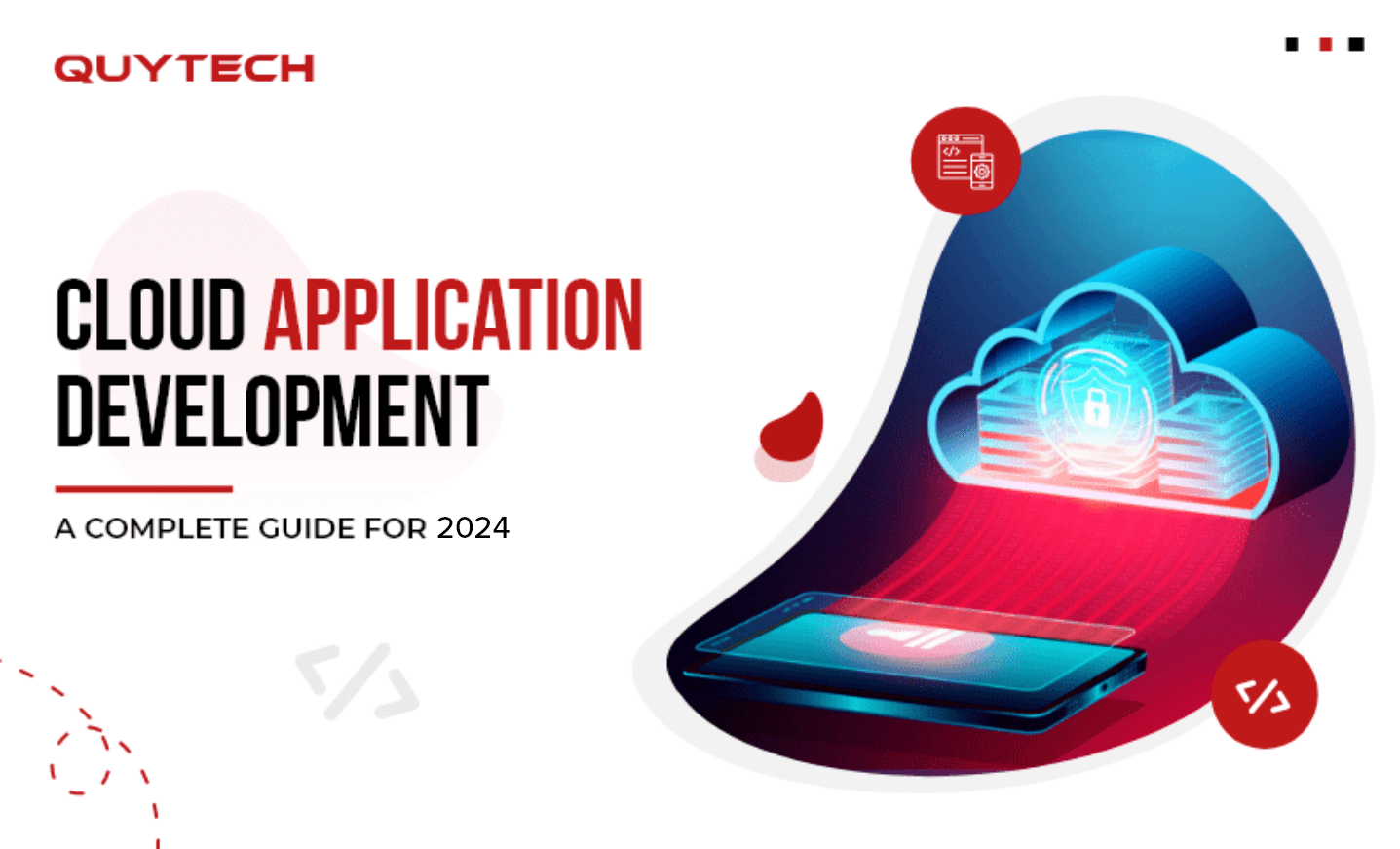Hey Readers,
Welcome to read a cloud-based application development guide!
A few years ago, every company was focused on business processes and digitization. Now the focus has shifted to developing new cloud-based applications and migrating to the cloud.
Many cloud platforms offer a wide range of business applications. However, out-of-the-box solutions can only cover some of the business needs in various industries. Therefore, some applications must be tuned, customized, or built from scratch in the cloud.
Willing not to get lost in this huge and complicated market, we prepared this guide. In the blog, you will get to know every single aspect related to cloud application development including the types of cloud app development, the benefits of cloud-based app development, the cost of cloud computing application development, and much more.
So, without wasting a minute, let’s get started with the interesting stats of cloud-based application development.
Cloud-based Application Development – Visionary Numbers?
- A report released by Gartner, by the year 2025, the public cloud will take the place of conventional applications, infrastructure, business process services, and system infrastructure solutions.
- As per the reports, the market for cloud applications is worth more than $150 billion.
- In 2025, spending on application software will rise from 57.7% to 65.9% of total expenditures.
- In the past, the global market for cloud computing was worth $371.4 billion, but it is expected to reach $1240.9 billion by 2027.
- According to Statista, the turnover of the cloud app market increases annually. Most notably, the market for cloud software is expected to reach $169 billion by 2025.
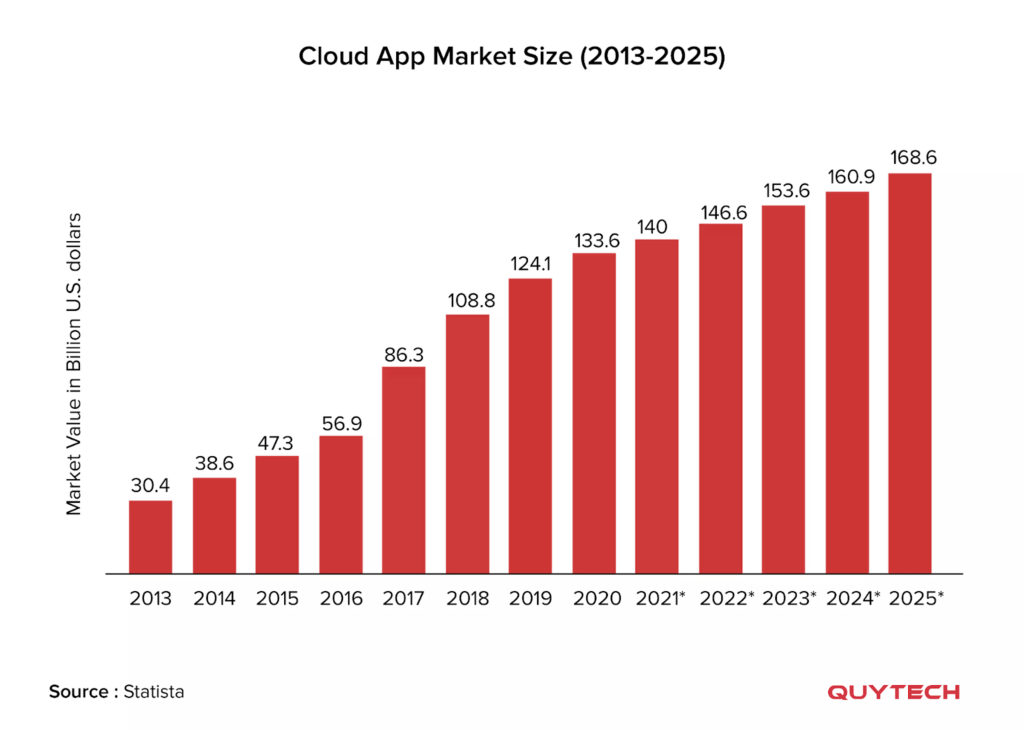
What Exactly Cloud-Based Apps Are?
A cloud-based application is a software application that runs on a remote server instead of a local computer or device. This type of application is also sometimes known as an online or web-based application. Let’s understand it with an example.
A local app is one that you use on your phone. It stores data locally on your phone and runs on the operating system of your phone. A cloud-based application also runs on an operating system, but it is not stored locally. Instead, it is stored on a remote server (in the cloud) and accessed over the Internet.
Google docs is a cloud-based application. It is an online word-processing application that allows you to create and edit documents in your web browser. Additionally, you can collaborate on these documents in real time by sharing them with others. Since Google Docs is a cloud-based application, you can access it from any device with an Internet connection.
Different Types of Cloud-Based Solutions
Each cloud-based solution has its own set of advantages and disadvantages. Some of the most popular choices are as follows:
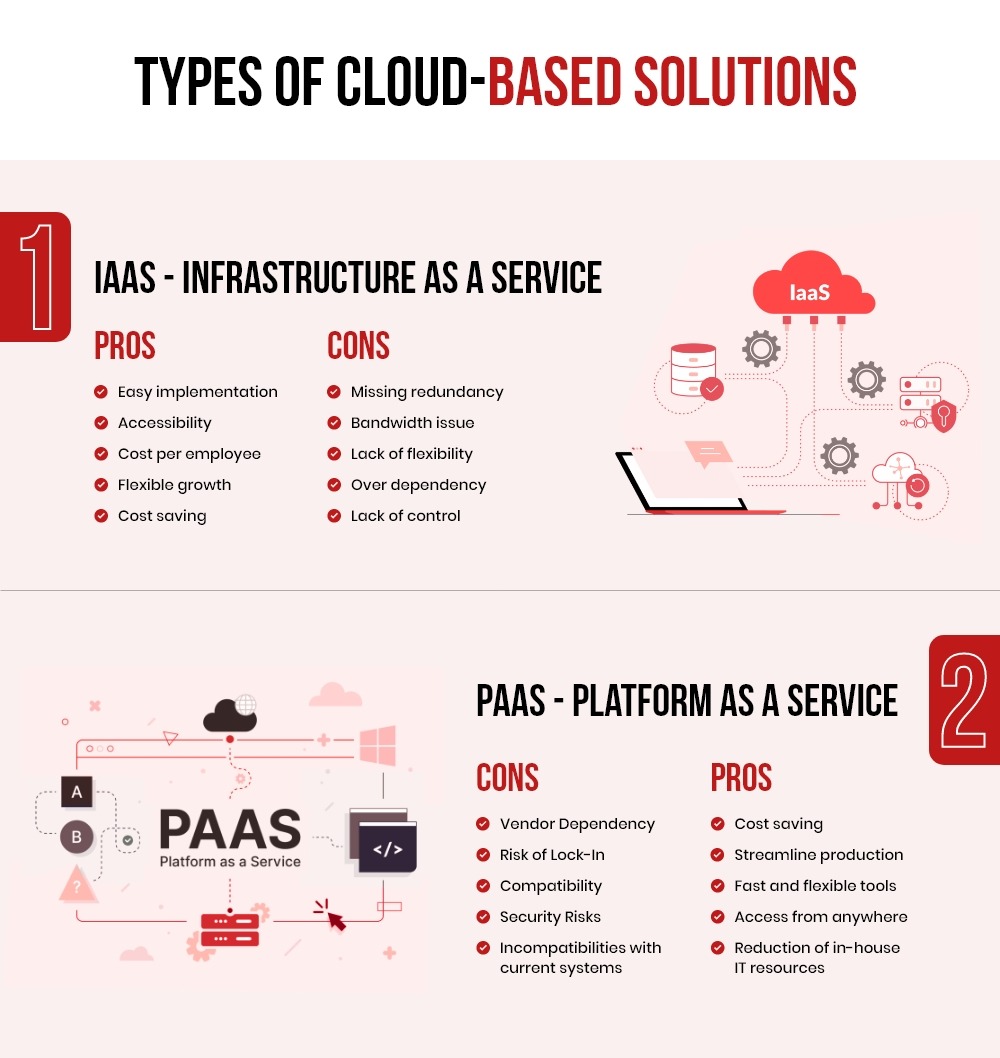
Infrastructure as a Service (IaaS)
IaaS is a type of cloud computing that provides computing infrastructure (including servers, storage, networking, and data center space) on a pay-as-you-go basis. IaaS providers typically charge by the number of resources per hour used. IaaS-based applications are
- Amazon EC2
- Digital Ocean
- Azure virtual machines
- IBM Cloud Pak for data
Platform as a Service (PaaS)
In PaaS, you get a platform for cloud application development. PaaS providers offer numerous tools and services that make it easy to develop, test, and deploy applications in the cloud. Some of the PaaS-based applications are the following:
- Google Cloud
- IBM Cloud
- Microsoft Azure Pipelines
Benefits of Cloud-Based Applications
Businesses can reap numerous benefits from cloud-based applications; Here are a few important ones:
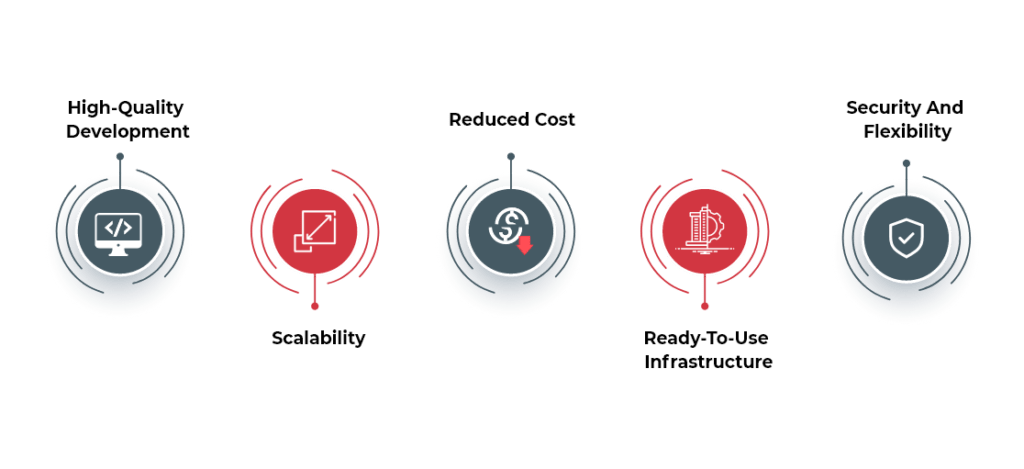
01- High-Quality Development
When you develop an application in the cloud, you can be sure that you are using the best possible infrastructure and tools. As a result, the product is of higher quality and more scalable.
Plus, cloud-based development makes it easy to track bugs and failures, so you can fix them quickly before they cause major problems.
02- Scalability
As business needs change and grow, cloud-based applications are designed to scale accordingly. Using cloud-based applications offers significant advantages in terms of scalability. As it allows companies to avoid the hassle and expense of constantly updating their on-premises software.
Cloud-based applications can be scaled up or down as needed, making them perfect for businesses of all sizes.
03- Reduced Cost
One of the great benefits of cloud-based applications is that they can help reduce costs for your business. For example, you can eliminate the need for expensive on-premises hardware and software and save on energy costs by running your applications in the cloud.
Additionally, cloud-based applications are scalable to meet changing requirements, so you only pay for what you use.
04- Ready-to-use Infrastructure
Last but not least, cloud-based applications offer a ready-to-use infrastructure. This can be a huge time saver for businesses as they don’t have to worry about setting up and maintaining their servers and other IT infrastructure.
They can instead make use of the infrastructure that the cloud application provider offers. This can save companies a lot of money and hassle in the long run.
05- Security and Flexibility
Cloud-based apps are incredibly secure. Because all data is stored in the cloud, it won’t be affected if something happens to your device. Additionally, cloud-based applications are continuously backed up, ensuring that you will never lose important data.
When it comes to flexibility, cloud-based applications are incredibly flexible. You can access them from anywhere, at any time. Moreover, data can be shared with anyone, no matter where they are.
How to Develop Cloud Applications?
Here, we are going to mention the process of cloud app development using DevOps, microservices, and serverless architectures. So, let’s take a quick look:
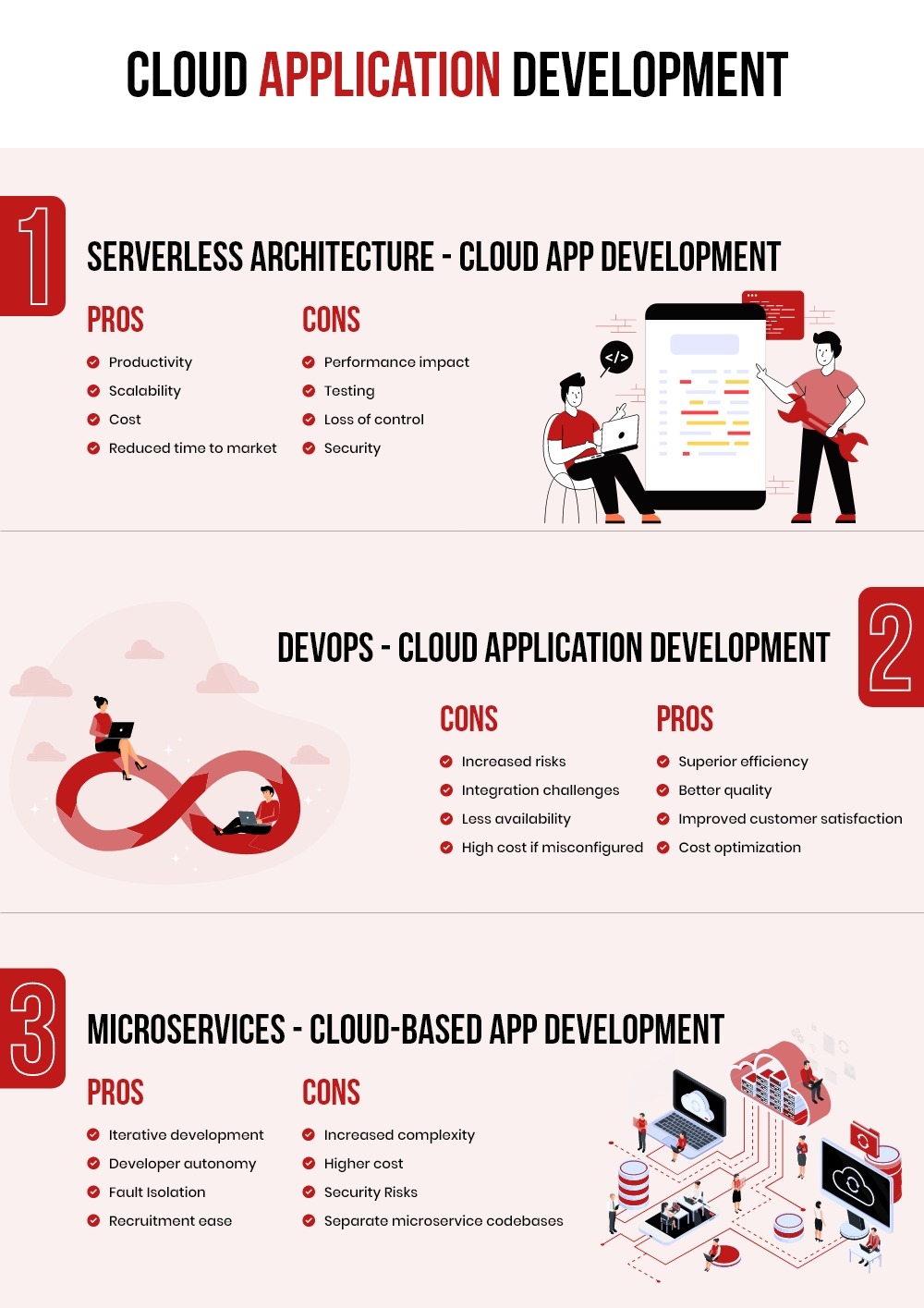
Cloud-Based Application Development – Using DevOps
When developing cloud-based applications, the change must start with software engineering, not at the C-tier. All those who will lead the process must be aware of the benefits of cloud application development using cutting-edge DevOps tools. Those not on board will likely impede progress and fail to adequately address ensuing problems.
We need to use cloud and non-cloud-based DevOps automation to automate agile procedures. At the same time, we must consider ways to automate those DevOps processes and incorporate public or private clouds.
Considering DevOps cloud services, this is easier said than done. So, the following are the steps that seem to work best.
- Specify the criteria for its development. Look through what you are doing right now and what you need to do in the future.
- Specify preliminary DevOps procedures. Remember that as we refine these procedures through evaluation, experimentation, and many errors, they will continually change.
- Describe the fundamental approach to DevOps and how it connects to the cloud platform(s). DevOps tools cannot be defined without first understanding the target platform or platforms. DevOps procedures, automation, culture, and target platform must work together in harmony. The what and the how must be decided. The complexity of all the additional moving components causes most businesses to fail at this point. In terms of missed opportunities within new cloud platforms that remain untapped for various reasons, they fall short.
- Be aware of your population. DevOps and making DevOps drive development in the cloud requires everyone’s support. This appears to be a problem in many businesses despite the fact that DevOps and the cloud are relatively new technologies. Traditional developers who want to learn but require a lot of direction tend to be impressed by embracing both new methods simultaneously. Your training won’t help you either. There should be no question about the new procedures, equipment, software, platforms, and daily routines; leadership is something that must come from the creators.
- Describing CloudOps, the method by which applications will run in the cloud. Most developers don’t want to get involved in operations. That can’t be the case with this new model. The method of throwing code against the wall and hoping for the best is no longer applicable. Developers should have new and improved visibility into how their applications are performing thanks to DevOps and the cloud.
Cloud-Native Applications and Microservices
The adoption of a microservices model should not be done in a hurry or even in one fell swoop. It’s a better idea to start small and build your successful microservice model after another.
In addition to the numerous technical difficulties that must be overcome during a digital transformation, converting to a cloud-native microservices model necessitates a cultural shift.
Getting people away from the way things have always been done is a difficult task in any industry or organization, and software development is no different. Employers who want to successfully implement a new cloud-native microservices strategy will need to be trained and encouraged to adopt the strategy.
So, get in touch with our experts today to successfully implement a new cloud-native microservices strategy for your organization.
We Can Make Your Business Model Serverless- Let’s Know How?
At Quytech, we help organizations around the world develop their applications with serverless architecture. Here’s how we help businesses build a serverless app:
- We understand the needs of customers.
- Next, we decided on a specific technology stack for the serverless application.
- Then, we offer an app-build strategy and confirm our estimates.
- We started building the system infrastructure and writing the documentation.
Ultimately, we set up a data storage environment in the Amazon S3 bucket or Amazon Redshift data storage cluster.
Let’s move forward, let’s quickly check the cost of cloud application development so that you decide whether or not to proceed with cloud-based application development.
How Much Does It Cost For Cloud Application Development?
The cost of developing an application in the cloud depends on the factors mentioned below:
- Product design
- Product characteristics
- Location and rate of your outsourced development team
- Project size and complexity
- Technology stack
- Time frame
To get an exact cloud app development cost, you need to connect with us. As a leading provider of cloud-based application development services, we can provide an accurate estimate of cloud application development costs, taking all factors into account.
The best part of cloud app development services is that you don’t have to deal with any kind of server fees, hardware complexities, or data storage issues. However, it is not an easy job to manage the development of cloud-based solutions as there are always some challenges coming your way.
Challenges in Cloud Application Development
As a cloud developer, you may face multiple challenges in developing cloud-based applications. Let’s go through each challenge one by one.
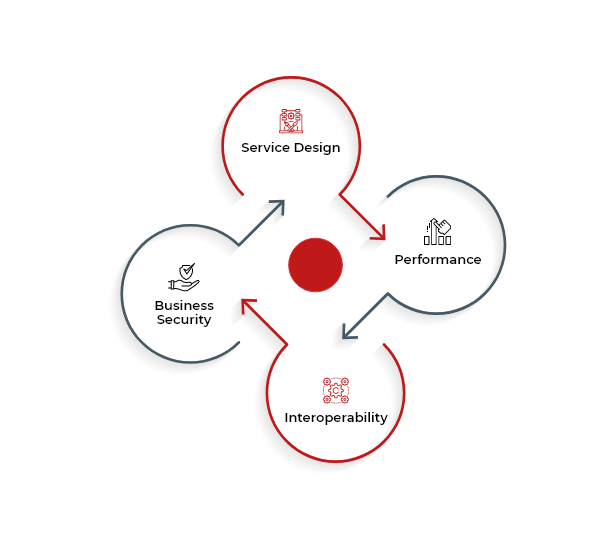
#1- Service Design
For cloud application developers, it could be challenging to design flexible and reusable components, as cloud applications must be tightly coupled with service logic and implementations.
#2- Performance
You may need to use content delivery networks (CDNs) such as Google Cloud CDN or Microsoft Azure CDN to speed up content delivery and increase page load speeds on cloud infrastructure.
#3- Interoperability
With the cloud, you can face challenges writing code that works well with multiple cloud providers simultaneously. You must follow standardized operating protocols, which makes them easy to implement.
#4- Business Security
Cloud-based applications store a large amount of private information, ensuring business security. However, cloud application development companies are somewhat prone to cloud security risks. To overcome this, businesses need to make sure to use SSL protocols and different types of encryption, including DES (Encryption Data Standard), 3DES (Triple Data Encryption Standard), and AES (Advanced Encryption Standard).
Incorporating the right security protocols helps businesses ensure better business security, and in turn, results in improved profits and application success in a very short time.
You have learned about the challenges of cloud application development. If you plan to build an app in the cloud, you may want to know the cost of developing the app.
How Quytech Can Help You With Cloud Application Development
We are a leading mobile app development company with expertise in technologies such as cloud computing, AR/VR, AI/ML, data analytics, and more. As part of our application development services, our experts can help you select a cloud model IaaS and PaaS that fits your business needs. Our experts provide world-class cloud consulting services for every business requirement, whether it’s an on-premises data center or a third-party host.
We offer cloud consulting, cloud machine learning, cloud-native development, and flexible cloud management services that get results. Without wasting your crucial time, get in touch with our app development consultants and get complete information for the same.
Frequently Asked Questions
Q1. What is cloud application development?
Cloud application development is a software development process to create a cloud-based application. This process consists of some main stages: Discovery, planning, design, development, testing, deployment, maintenance, and support.
Q2. What is a cloud-based application?
A cloud-based application is software that runs its data storage and processing over the Internet. Data exchange occurs between two systems: the server side and the client side.
Q3. What are the pitfalls concerning cloud application development?
However, some of the pitfalls of choosing cloud computing can include technical errors, security breaches, and potential attacks that can harm a business in the long run.
Q4. What makes cloud computing the foreseeable future of technology?
According to some cloud application development companies, the technological future will be extremely competitive and will require flexible technologies to survive over time. One such technology that can help your business save money on servers, management services, data processing, and storage is cloud computing. Your operations become more efficient while you save time and money thanks to the low cost of moving these resources to the cloud.
Q5. What tools are used in cloud application development?
There are a variety of tools that can be used in cloud application development, depending on the specific needs of the project. Some standard tools include Cloud IDE, AWS Lambda, Serverless Framework, and Azure Functions.

